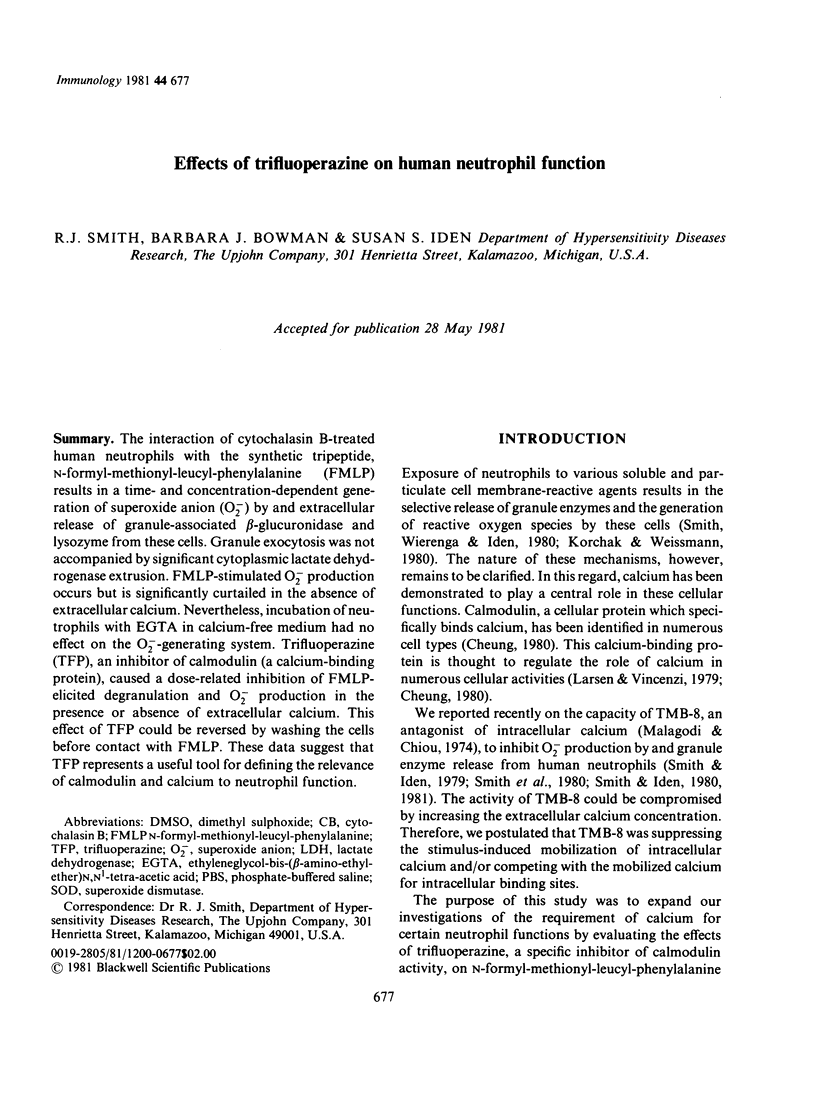Abstract
The interaction of cytochalasin B-treated human neutrophils with the synthetic tripeptide, N-formyl-methionyl-leucyl-phenylalanine (FMLP) results in a time- and concentration-dependent generation of superoxide anion (O2-) by an extracellular release of granule-associated beta-glucuronidase and lysozyme from these cells. Granule exocytosis was not accompanied by significant cytoplasmic lactate dehydrogenase extrusion. FMLP-stimulated O2- production occurs but is significantly curtailed in the absence of extracellular calcium. Nevertheless, incubation of neutrophils with EGTA in calcium-free medium had no effect on the O2- -generating system. Trifluoperazine (TFP), an inhibitor of calmodulin (a calcium-binding protein), caused a dose-related inhibition of FMLP-elicited degranulation and O2- production in the presence of absence of extracellular calcium. This effect TFP could be reversed by washing the cells before contact with FMLP. These data suggest that TFP represents a useful tool for defining the relevance of calmodulin and calcium to neutrophil function.
Full text
PDF







Selected References
These references are in PubMed. This may not be the complete list of references from this article.
- Babior B. M., Kipnes R. S., Curnutte J. T. Biological defense mechanisms. The production by leukocytes of superoxide, a potential bactericidal agent. J Clin Invest. 1973 Mar;52(3):741–744. doi: 10.1172/JCI107236. [DOI] [PMC free article] [PubMed] [Google Scholar]
- Goldstein I. M., Horn J. K., Kaplan H. B., Weissmann G. Calcium-induced lysozyme secretion from human polymorphonuclear leukocytes. Biochem Biophys Res Commun. 1974 Sep 23;60(2):807–812. doi: 10.1016/0006-291x(74)90312-x. [DOI] [PubMed] [Google Scholar]
- Hoffstein S. T. Ultrastructural demonstration of calcium loss from local regions of the plasma membrane of surface-stimulated human granulocytes. J Immunol. 1979 Sep;123(3):1395–1402. [PubMed] [Google Scholar]
- Korchak H. M., Weissmann G. Stimulus-response coupling in the human neutrophil. Transmembrane potential and the role of extracellular Na+. Biochim Biophys Acta. 1980 Sep 2;601(1):180–194. doi: 10.1016/0005-2736(80)90523-4. [DOI] [PubMed] [Google Scholar]
- Larsen F. L., Vincenzi F. F. Calcium transport across the plasma membrane: stimulation by calmodulin. Science. 1979 Apr 20;204(4390):306–309. doi: 10.1126/science.155309. [DOI] [PubMed] [Google Scholar]
- Levin R. M., Weiss B. Mechanism by which psychotropic drugs inhibit adenosine cyclic 3',5'-monophosphate phosphodiesterase of brain. Mol Pharmacol. 1976 Jul;12(4):581–589. [PubMed] [Google Scholar]
- Malagodi M. H., Chiou C. Y. Pharmacological evaluation of a new Ca2+ antagonist, 8-(N,N-diethylamino)-octyl-3,4,5-trimethoxybenzoate hydrochloride (TMB-8): studies in smooth muscles. Eur J Pharmacol. 1974 Jun;27(1):25–33. doi: 10.1016/0014-2999(74)90198-8. [DOI] [PubMed] [Google Scholar]
- Smith R. J., Iden S. S. Modulation of human neutrophil superoxide anion generation by the calcium antagonist 8-(N,N-diethylamino)-octyl-(3,4,5-trimethoxy) benzoate hydrochloride. J Reticuloendothel Soc. 1981 Mar;29(3):215–225. [PubMed] [Google Scholar]
- Smith R. J., Iden S. S. Phorbol myristate acetate-induced release of granule enzymes from human neutrophils: inhibition by the calcium antagonist, 8-(N,N-diethylamino)-octyl 3,4,5-trimethoxybenzoate hydrochloride. Biochem Biophys Res Commun. 1979 Nov 14;91(1):263–271. doi: 10.1016/0006-291x(79)90612-0. [DOI] [PubMed] [Google Scholar]
- Smith R. J., Iden S. S. Properties of concanavalin A-elicited granule exocytosis from human polymorphonuclear neutrophils. Inflammation. 1980 Dec;4(4):343–358. doi: 10.1007/BF00916046. [DOI] [PubMed] [Google Scholar]
- Smith R. J., Ignarro L. J. Bioregulation of lysosomal enzyme secretion from human neutrophils: roles of guanosine 3':5'-monophosphate and calcium in stimulus-secretion coupling. Proc Natl Acad Sci U S A. 1975 Jan;72(1):108–112. doi: 10.1073/pnas.72.1.108. [DOI] [PMC free article] [PubMed] [Google Scholar]
- Smith R. J. Modulation of phagocytosis by and lysosomal enzyme secretion from guinea-pig neutrophils: effect of nonsteroid anti-inflammatory agents and prostaglindins. J Pharmacol Exp Ther. 1977 Mar;200(3):647–657. [PubMed] [Google Scholar]
- Smith R. J., Sabin C., Gilchrest H., Williams S. Effect of anti-inflammatory drugs on lysosomes and lysosomal enzymes from rat liver. Biochem Pharmacol. 1976 Oct 1;25(19):2171–2177. doi: 10.1016/0006-2952(76)90129-5. [DOI] [PubMed] [Google Scholar]
- Smith R. J. The guinea pig neutrophil calcium-dependent lysosomal enzyme secretory process. Biochem Pharmacol. 1979 Sep 15;28(18):2739–2746. doi: 10.1016/0006-2952(79)90557-4. [DOI] [PubMed] [Google Scholar]
- WOODIN A. M., WIENEKE A. A. The accumulation of calcium by the polymorphonuclear leucocyte treated with staphylococcal leucocidin and its significance in the extrusion of protein. Biochem J. 1963 Jun;87:487–495. doi: 10.1042/bj0870487. [DOI] [PMC free article] [PubMed] [Google Scholar]
- Weissmann G., Korchak H. M., Perez H. D., Smolen J. E., Goldstein I. M., Hoffstein S. T. The secretory code of the neutrophil. J Reticuloendothel Soc. 1979 Dec;26(Suppl):687–700. [PubMed] [Google Scholar]
- Williams L. T., Snyderman R., Pike M. C., Lefkowitz R. J. Specific receptor sites for chemotactic peptides on human polymorphonuclear leukocytes. Proc Natl Acad Sci U S A. 1977 Mar;74(3):1204–1208. doi: 10.1073/pnas.74.3.1204. [DOI] [PMC free article] [PubMed] [Google Scholar]


